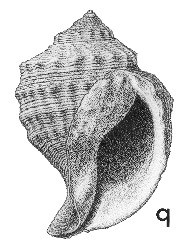
Revised descriptions of New Zealand Cenozoic Mollusca from Beu and Maxwell (1990)

 | Revised descriptions of New Zealand Cenozoic Mollusca from Beu and Maxwell (1990) | 
|
  (Pl. 20q): GS9520, J41/f8029, Awamoa Creek, Oamaru, Altonian (GNS) |
Beu & Maxwell (1990): Chapter 11; p. 193; pl. 20 q.
Synonymy: ‘Galeodea senex (Hutton)’ of authors; Galeodea apodemetes Marwick 1934, p. 12; Galeodea (Galeodea) apodometes, Beu & Maxwell 1990, p. 193, pl. 20q.
Classification: Cassidae: Cassinae
Description: Size moderate for genus (height 35-50 mm), broadly pyriform, spire 0.25-0.3 total height. Protoconch naticiform, of about 1.5 smooth whorls. Teleoconch whorls 4-5, shouldered at or near middle on spire, sutural ramp broad, almost flat; last whorl with 2 or 3 additional angulations, base excavated, with a strongly twisted neck. Axial sculpture of tubercles or nodules on angulations, not agreeing with those on other angulations in number or position, those on shoulder angle less numerous and more prominent than those below; 13-15 shoulder tubercles per whorl. Spiral sculpture of numerous narrow cords with occasional interstitial threads, covering virtually all of teleoconch. Aperture pyriform with a narrow siphonal canal that in complete shells is strongly twisted to left and away from aperture. Inner lip prominently callused, expanded freely over columella, sculpture on last whorl showing through on parietal region, otherwise smooth. Outer lip with a narrow, rounded varix, which does not extend onto canal, leading edge finely crenulate, smooth within except for a tubercle near adapical end in some shells.
Comparison: Galeodea apodemetes is by far the most widely recorded and therefore best-known fossil species of Galeodea from New Zealand. It is readily distinguished from G. modesta (Pl. 6l) by its coarser spiral sculpture and in having the inner and outer lips almost completely smooth. G. triganceae (Waipipian-Recent) is much closer but differs in having a less thickened outer lip and in having two rather than only one row of nodules visible on spire whorls. An undescribed species from Tongaporutuan localities in North Canterbury also seems to be closely related to G. apodemetes, differing in having considerably coarser spiral sculpture, particularly on the whorl angles.
The rather limited available evidence suggests that Galeodea has undergone some restriction in habitat in New Zealand during the Cenozoic. The Bortonian species G. modesta is recorded from shallow water (inner or mid-shelf) assemblages, and the contemporary G. geniculosa (Hampden) from deeper water (outer shelf or upper slope) facies. G. apodemetes seems to have been most common in the mid- or outer shelf region but also to have extended into shallower waters and into the upper bathyal zone. After the Altonian the record of the genus becomes very patchy. An undescribed species (with an armoured aperture and therefore unlike G. apodemetes) is present in the Slip Point Siltstone (Clifdenian) at Clifden, and another undescribed species is recorded from the Tongaporutuan of Kaiwara Valley, North Canterbury, associated with upper bathyal molluscs. The extant G. triganceae is typically bathyal in distribution, although a few specimens (including the type material) are from mid-shelf depths. Fossil records of G. triganceae are from the Whenuataru Tuff on Pitt Island (Waipipian) (? outer shelf) and from Palliser Bay (Mangapanian) and Oaro, Marlborough (Nukumaruan) in both cases associated with diverse upper bathyal faunules (Beu 1967a, p. 100; 1979, p. 91). The Castlecliffian and Recent species G. plauta Beu, 2008 (which has a wider sutural ramp than species of the G. apodometes-triganceae group) also seems to have undergone habitat change recently, as the few known Castlecliff fossils (in Upper Westmere Siltstone) occur with outer shelf faunas, and it seems to have descended from the shelf species G. sulcata (Hutton, 1873) (Kapitean-Opoitian, Westland), whereas all Recent specimens are from upper bathyal depths off western Northland.
Distribution: Duntroonian-Altonian; Mount Harris Formation, Awamoa Creek, Oamaru, Altonian (type) and other Altonian localities in Oamaru district; Otekaike Limestone, Sister's Creek, Hakataramea Valley; Mount Harris Formation, Dyer's Run, Waihao Valley; Southburn Sand, Tengawai River near Sutherlands.
Cite this publication as: "A.G. Beu and J.I. Raine (2009). Revised
descriptions of New Zealand Cenozoic Mollusca from Beu and Maxwell (1990). GNS
Science miscellaneous series no. 27."
© GNS Science, 2009
ISBN
978-0-478-19705-1
ISSN 1177-2441
(Included with a PDF facsimile file
copy of New Zealand Geological Survey Paleontological Bulletin 58 in CD version
from: Publications Officer, GNS Science, P.O. Box 30368 Lower Hutt, New
Zealand)